Off-Road.com Editor Josh Burns gives DBC some insight into opportunities that Moab, Utah, offers dirtbike riders.
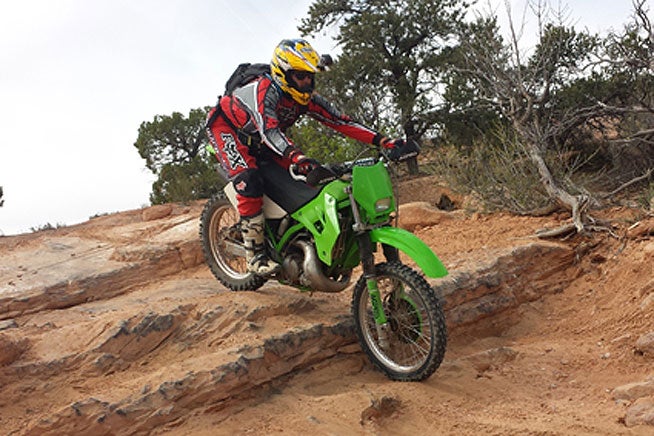
My position as Editor of DirtBikes.com’s sister site, Off-Road.com has allowed me to attend the Easter Jeep Safari in Moab, Utah, for the past several years. The area’s old uranium mine trails offer a wealth of off-road exploration opportunities, and every year, just before Easter Weekend, thousands of off-road enthusiasts, Jeep clubs and off-road vendors descend upon the town of Moab for a week’s worth of four-wheel-drive fun. They’ve been doing it for decades, and it’s one of the largest and most well-known off-road gatherings in the USA.
But one of the biggest misconceptions about the Easter Jeep Safari is that it’s just for Jeepers. While Jeepin’ in actual Jeeps was the genesis of the event nearly 50 years ago, trucks, SUVs and rigs of all shapes and sizes now participate in the event every year. Having attended a number of Easter Jeep Safari events over the years, one day I realized that exploring some of these trails on a dirt bike could bring an entirely new dimension to the trip. Losing the larger, slow-moving organized groups and enjoying the freedom to explore the slickrock sections on two wheels instead of four, had the potential to be a blast.
So, a few years ago a colleague and I did just that, and it was awesome. Our busy work schedule only allowed us to take a few rides during the week, but we came away with a fresh perspective and a deeper appreciation for what Moab has to offer. This year, we brought our bikes with us again, and this time we decided to explore some of the better-known four-wheel trails. Just like before, it was great fun.
If you’ve ever visited Moab, you’re probably familiar with just how beautiful the area really is. With its red rock mountains, slickrock trails and scenic vistas, it’s an off-roaders paradise. Here’s a breakdown of some of the more popular areas and trails worthy of consideration if you should ever get the chance to explore Moab on two wheels.
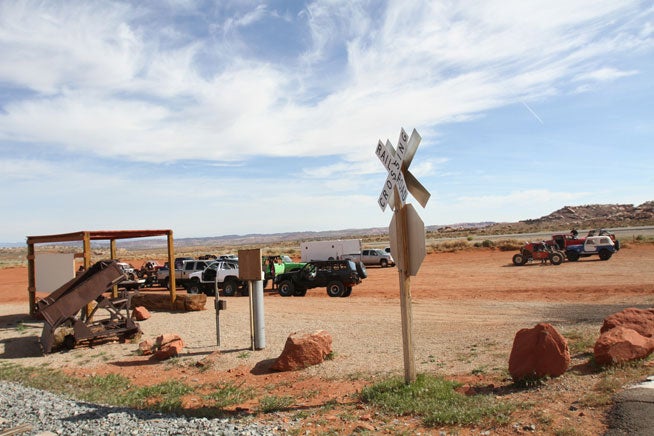
We headed just outside of town on the 191 and stopped at the Gemini Bridges Trailhead. The area is the access point to a number of trails, as Gemini Bridges Road travels up along the side of the mountain overlooking 191 and then turns away from the highway and meets up with trails such as Golden Spike, Metal Masher and more. For dirt bikers and ATV/UTV riders looking for a staging area to access trails, this is the perfect spot. The lot provides plenty of room for parking vehicles – even if you’re pulling a trailer. But remember, it is private land and parking fees are paid on the honor system.
Since we were heading out to explore trails and we weren’t exactly sure how long it would take, we made sure to top off our fuel tanks, fill up our CamelPaks with water, and we packed a small took kits, snacks and a cell phone. The arid climate makes water a necessity, so be sure to have plenty on hand.
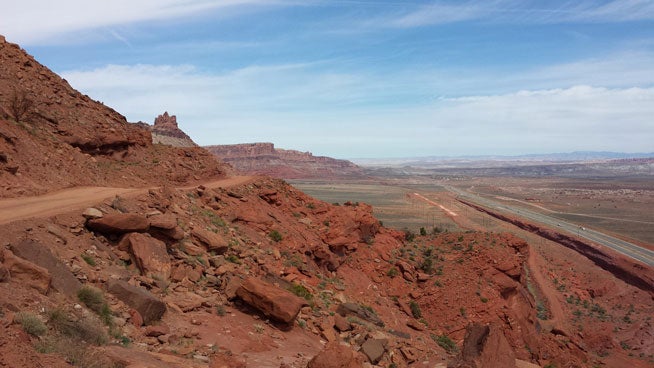
Only a few miles into the ride, Gemini Road provides cool scenery as the road increases in elevation and overlooks the 191 highway hundreds of feet below. It then turns the corner and heads toward a number of trails. We followed the road over to the Gemini Bridge, parked our bikes and walked the few hundred yards to the scenic spot. Gemini Bridge isn’t accessible by vehicle, but it’s worth walking to so that you can take in the view.
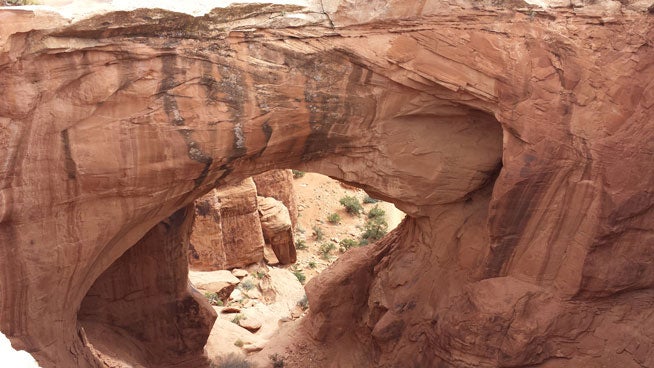
We headed a little further down the trail and made our way to the back entrance to Metal Masher. We were fortunate that no guided groups were on our section of the trail, so we were able to explore at our leisure. Metal Masher is a pretty cool trail overall. It offers smooth, sandy turn sections, rocky slopes and ledges, but best of all most of the obstacles have a bypass. While the trail might be on the gnarly side for beginners, intermediate riders should have no trouble negotiating it.
After a few hours of riding we did eventually catch up to a few organized Jeep groups tackling the trails. As is with any trail, courtesy is important when heading through tight sections or obstacles. We waited for the first group to pass before getting back on our way. Once we hit the slickrock sections, it was even easier to bypass the small groups of Jeepers on the trail, most of which gave us nods and waved hello. It was nice to see that we weren’t treated as second-class citizens because were weren’t driving Jeeps. All off-road enthusiasts should be so hospitable.
The cool part about riding in Moab is that there are a number of potential offshoots and connecting trails in the area, for further exploration. In one section of Metal Masher, there’s an optional trail that allows you to head over to Widow Maker, a gnarly obstacle that only the serious four-wheelers will try to tackle. Golden Spike and Poison Spider trail can also be accessed, and if you’re on a dual-sport bike you can ride on Gemini Road until it ends at highway 313. It’s important to map out your route ahead of time by familiarizing trail names, buying or printing out a trail map, and of course, planning ahead with extra water and snacks. Cell reception is limited in some remote areas of Moab, but we did have service in some sections on the trail, so bringing a cell phone is a good idea.
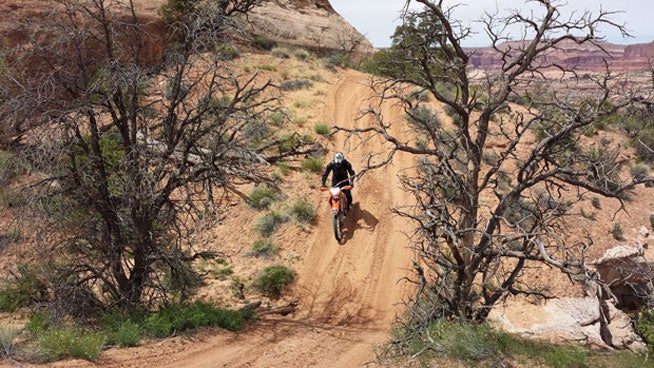
After finishing our ride at Metal Masher, we rode back to the staging area and headed back into town for lunch. We spent most of the morning on just that part of the ride, and we could easily have stretched it into a full day, but we wanted to make sure we hit some other trails, so we ventured over to the Grand County Sand Flats Recreation Area. This area provides access to notable trails such as Hell’s Revenge, Fins & Things and access to the Kokopelli Trail. Overnight camping is available in the park, and both motorized recreation for four wheeling or powersports, mountain biking and hiking are all allowed in the park.
Once inside, we headed over to Fins & Things. We’ve been on a number of trail rides on this famous and fun Moab trail over the years, and we even took a short spin on it when he had our bikes with us a few years back. The trail is such a blast on bikes we wanted to hit it again. We did a few laps around the trail, cutting out some of the slickrock sections because a few large organized trail runs were taking place, and we didn’t want to be a nuisance. The four-wheelers had shown us respect, and we were happy to reciprocate.
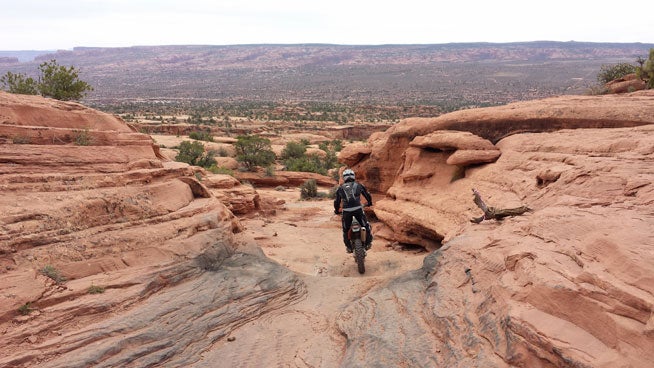
While we only tackled a few more trails during this visit to Moab, we wish we had even more time to ride. Moab is a playground for the adventurous, offering a massive variety of outdoor recreation that’s set in a beautiful and scenic landscape. It’s a well-known destination for four-wheel recreation, but it should also be on the bucket list for riders who fancy themselves as explorers.
Then again, maybe I should’ve kept my mouth shut. The fewer that know how great Moab is as a dirt bike destination, the less crowded it will be the next time we go back to hit the trails.
 Your Privacy Choices
Your Privacy Choices